Do you have a morning message in your preschool or pre-k classroom? This literacy best practice is one that is often misunderstood in the early childhood classroom. Here’s a simple definition and some morning message tips and tricks you can use to get started with a successful morning message in your classroom right away.
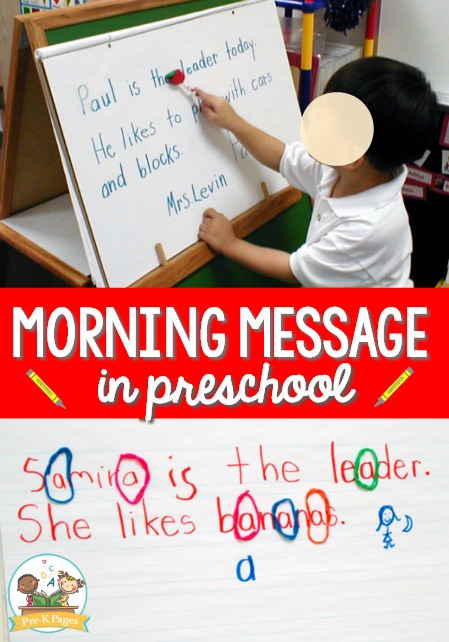
What is Morning Message?
Morning Message is an interactive teaching method that introduces students to the writing process. Unfortunately, morning message is one of those practices that started in the older grades and was pushed down to preschool without much understanding or adaptation.
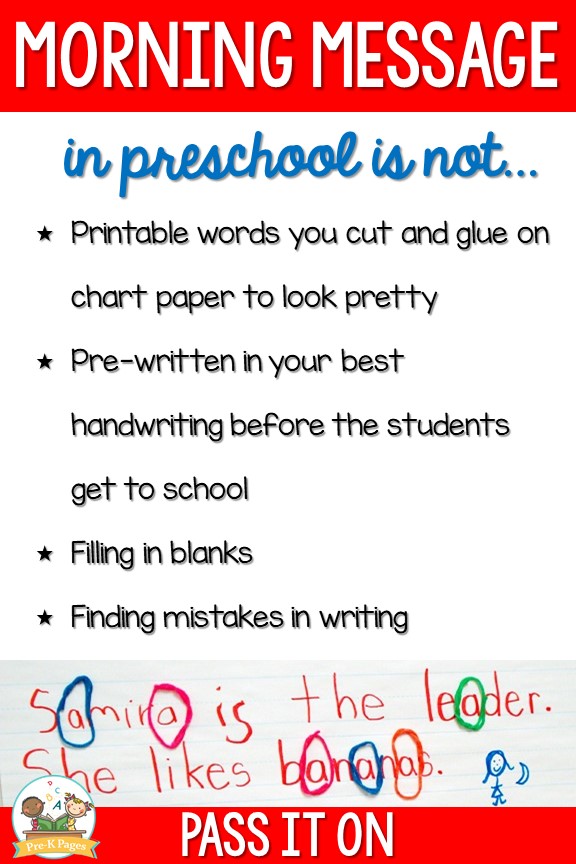
Morning Message is NOT
Morning message in preschool is NOT:
- A bunch of pre-scripted, printable words you cut and paste on chart paper to look pretty
- Pre-written in your best penmanship before the kids get to school
- Filling in blanks
- Finding mistakes in writing
These methods listed above don’t help young children learn how to write or become good writers.
Editing
I get asked often about the “finding mistakes” portion of this blog post in relation to editing. There is a big difference between asking young children to identify mistakes in pre-written text vs. correcting our own authentic mistakes during shared writing. Correcting our own mistakes when we write is authentic and meaningful for young children.
For example, if I am writing the word “lunch” in our message and I make a mistake and write “lnuch,” I might stop and say, “Wait, that doesn’t look right. I think I made a mistake right here. It’s okay to make mistakes, that’s something writers do. I’ll cover it with this tape and try again.”
I will model how to fix my mistake. This is an example of correcting a mistake authentically as opposed to finding mistakes in pre-written text.
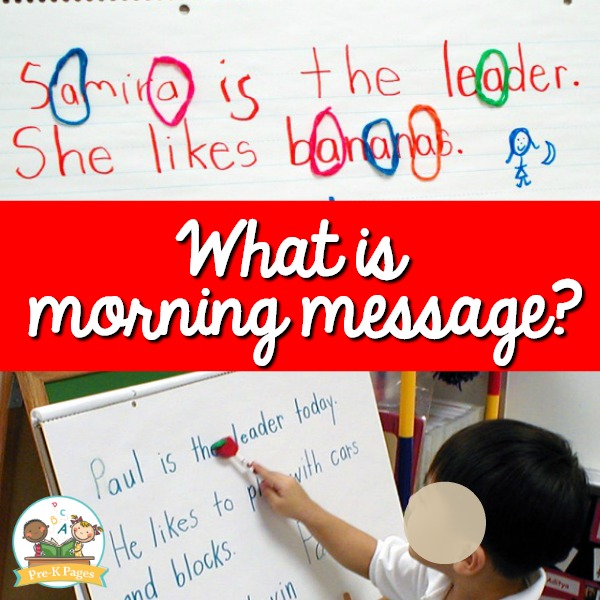
What is Morning Message?
The truth about morning message in preschool is that it should be fun, meaningful, and interactive.
Young children aren’t motivated to write through the use of controlled prompts that match the seasons, themes, or holidays, they are motivated by the world around them, use this motivation to your advantage and make learning authentic.
There isn’t even a need to actually call this process “morning message” in preschool, you can just say “Let’s write about it!”
Why Morning Message?
When students actually see and hear an adult think-aloud as they go through the writing process they will begin to understand the connections between the written word and oral language more clearly. They are observing concepts about print first hand. When you compose a Morning Message with your students you are helping them become successful, independent writers by modeling the writing process.
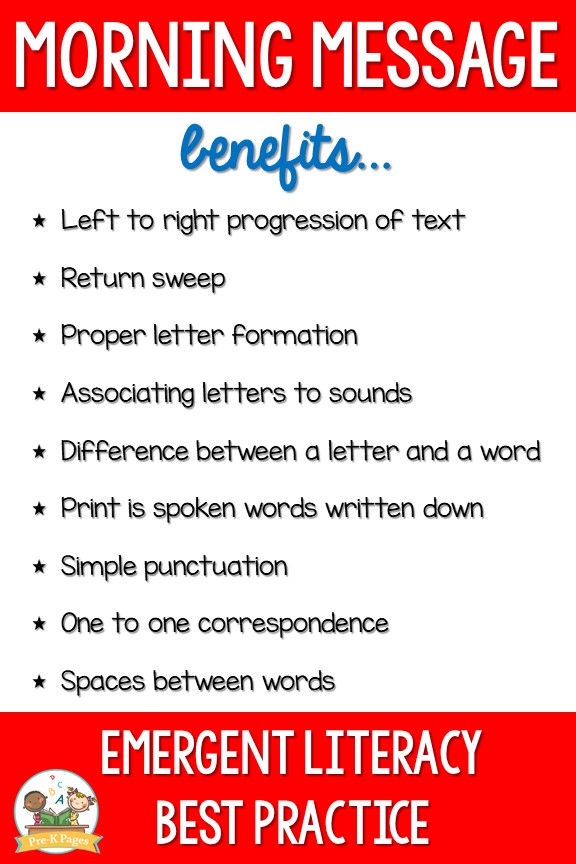
Benefits of Morning Message
Even students who do not know how to read, write, or even speak English will benefit immensely from the Morning Message. Some of the basic concepts you can cover in a Morning Message are:
- Left to right progression of text
- Return sweep
- Proper letter formation
- Associating letters to sounds
- Difference between a letter and a word
- Print is spoken words written down (print carries a message)
- Punctuation, like period and question mark
- One to one correspondence
- Spaces between words
- Common sight words
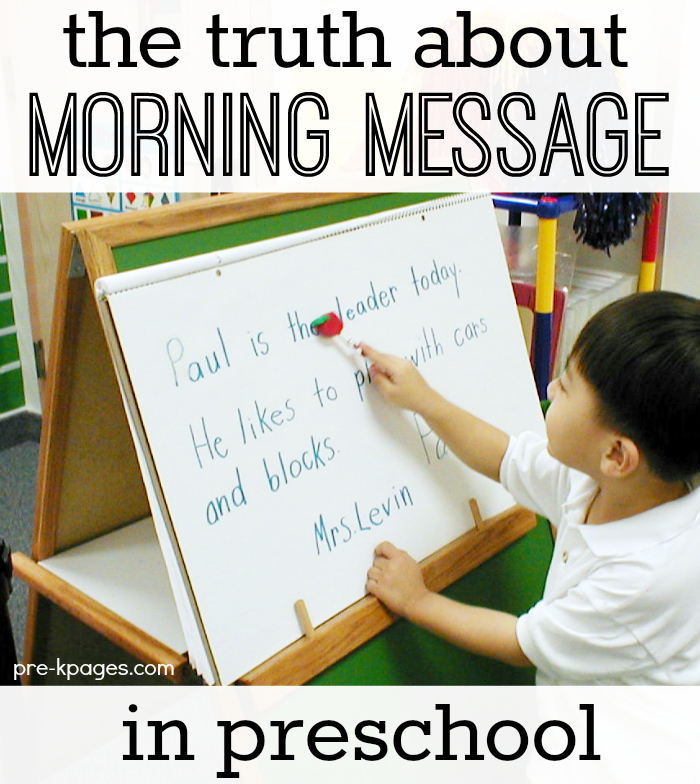
When Do You Do Morning Message?
Your students will be more successful with morning message when it is done on a daily basis.
What does Morning Message look like in the beginning?
We have an easel in our circle area that holds chart paper. On a shelf nearby the easel I have all the “tools” I may need; markers, pointers, pom-pom’s, Wikki Stix, microphones, magnifying glasses, and correction tape. The leader of the day comes to the front of the class and sits in my chair with a microphone.
What Do You Write About?
The first sentence of our Morning Message is always the same; “_______ is the leader today.” This helps to make the message meaningful to the students because they can all relate to and eventually identify their friends name in the message. As I write the first sentence, I spell aloud and use my fingers to make spaces between the words. When I come to the end of the sentence I place a period and say the child’s name aloud. After a few days of the Morning Message in the beginning of the year everybody can “read” the first line successfully.
The second line of the message is an original sentence from the leader. In the beginning of the year we usually start with “I like” statements. For example;
Leyla is the leader today.
Leyla said, “I like to eat pizza”.
Because pizza is a popular food among the Pre-K crowd, the word will have more meaning to them and they will therefore be excited about being able to identify it. When we are finished with the message we read it together as a class while I use a pointer, then the leader comes to the easel and “reads” the message using a pointer of his or her choice. After the message has been read we then move on to one of our Morning Message activities.
Sharing the Pen
For the first few weeks I’m just trying to get the routine of the Morning Message going and to move it along as fast as I can because their attention spans are non-existent. Once we have the routine down, then I start inviting students to share the pen.
Introducing Letter Sounds During Morning Message
I also start introducing letter sounds during this time. Here’s an example:
“Leyla is the leader today. Hmm, I wonder what letter Leyla starts with? I hear the “lll” sound, what letter makes that sound?”
Even if the students don’t know their letter sounds yet, some may know that Leyla starts with the letter “L”, so they begin making the connection.
Teaching Letter Formation During Morning Message
I invite a child to help me write the first letter of Leyla’s name. As the student holds the pen I will talk them through the letter formation.
“L is a straight line, start at the sky and go down to the ground, then over towards the door.”
We repeat the pen sharing a few more times during the creation of the Morning Message. If they become antsy, then you will know it’s time to move on. If a mistake is made when a student is holding the pen, the 2 inch correction tape takes care of it. I call it the “Magic Tape” and the kids love using it. If a child isn’t able to write a letter independently and asksfor help, then I will help by placing my hand over his or hers.
How do you keep the student’s attention?
This is the question I am asked most often, and the answer is to keep it fun and interactive for the children. I have actually had students who cried if something kept us from writing the Morning Message. Some of the Morning Message tools I use are:
- Wikki Stix: Colorful waxed strings
- Microphones: Pretend plastic microphones work well!
- Magnifying Glasses: Students use the magnifying glasses to help them find the mystery letter.
- Large Correction Tape
- Pointers
- Pom-Pom’s: I bought a dozen sets of colorful Pom-Pom’s from Oriental Trading.
- Glasses: I found a bag of Harry Potter glasses at the local Goodwill store for a dollar. We refer to these as “magic glasses” and the students can wear them when they search for specific letters.
- Magic Wand: The type that make noise are a HUGE hit with the kids 🙂 We use the magic wand to “read” the morning message when we’re finished writing.
Morning Message Activities
- Mystery Letter or Word: I cut the Wikki Stix in half and bend them into circles. After we have finished writing the Morning Message I will select one letter for the students to search for in the Morning Message (aka Mystery Letter). The Leader of the day will use the microphone to select a student to come up and search for the letter using the magnifying glass. When a letter is found, the student places the Wikki Stix circle around the letter. The number of helpers is determined by the number of mystery letters in the message. If it is the middle or end of the year and students are beginning to read or are just tired of the same old thing you can have them start searching for sight words.
- Rainbow Writing: We rainbow write the first letter of the leader’s name daily. If you do not have an ELMO, using a large piece of paper so the whole class can see is best. I write the leader’s first letter on the paper using a black marker, I talk through the writing so they can see and hear the correct letter formation. Then, the leader comes to the front and chooses a marker to trace over the first letter using correct letter formation. Next, the leader picks somebody and they come up and choose a different color and so forth until the letter has several different colors on it and looks sufficiently “rainbow like”. If you are using large chart paper these look great hanging on the wall around the classroom. If you use the ELMO I like to 3 hole punch them and put them in a binder for the children to read in the class library.
- Star Reader: We “read” the Morning Message together as a class after it is complete using one of our cool pointers. The Leader of the day then “reads” the Morning Message using a pointer of his or her choice. We will then say “Hooray, hooray, hooray for Star Reading!” using our Pom-Pom’s, leader’s choice of color. Depending on time, we may choose other star readers.
Teaching Trailblazers
Using a morning message is important, but it’s only one small piece of the literacy puzzle. If you really want to be the best teacher you can be, the best place to learn more about current best teaching practices and get the support you need is in the Teaching Trailblazers. We have many printable lessons and on-demand video trainings to help you become the best teacher you can be! If you want to get on the waiting list for the Teaching Trailblazers, do it soon so you don’t miss the next open enrollment period!
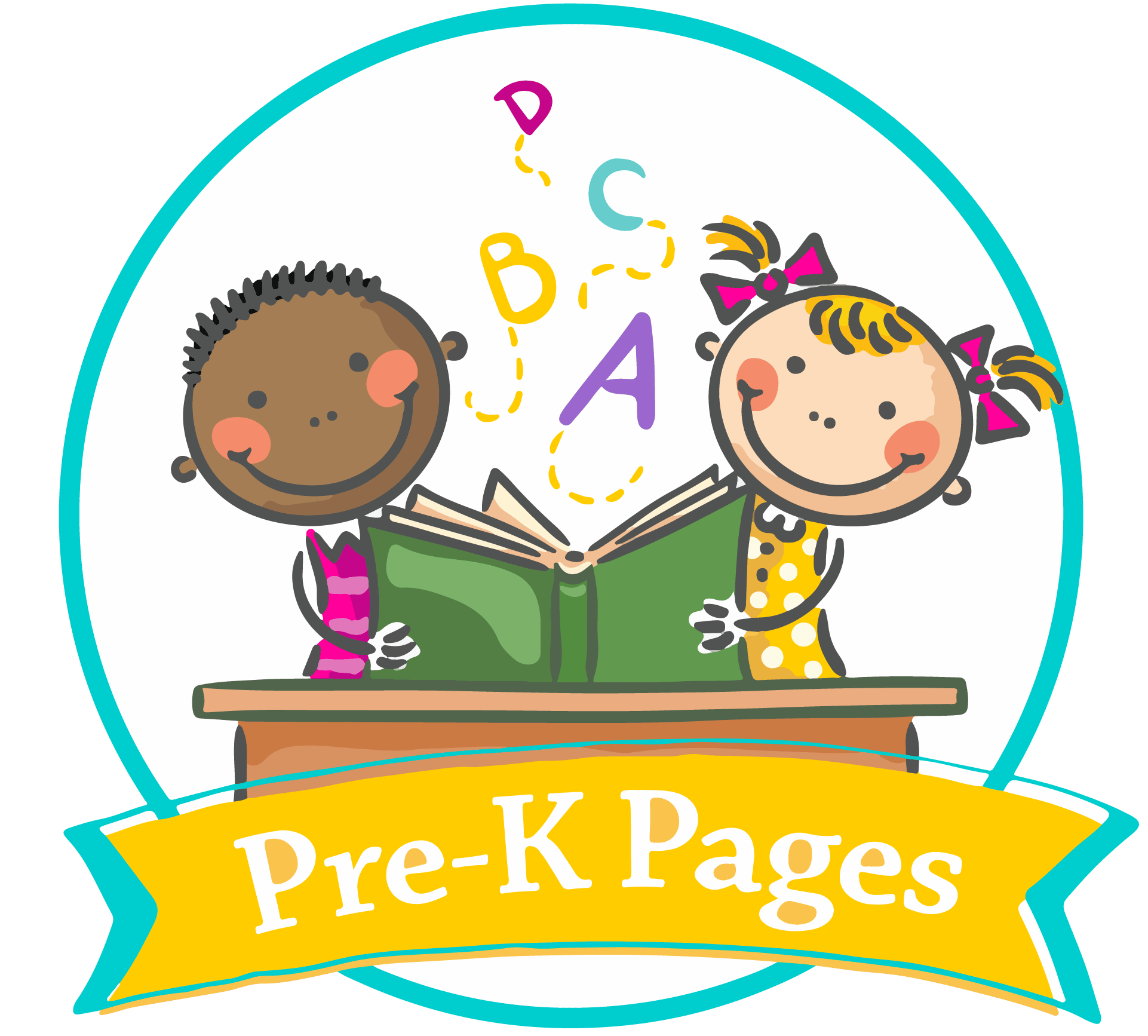
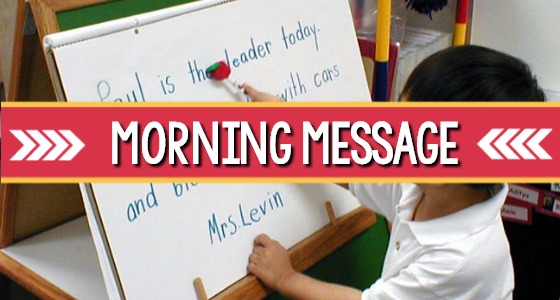
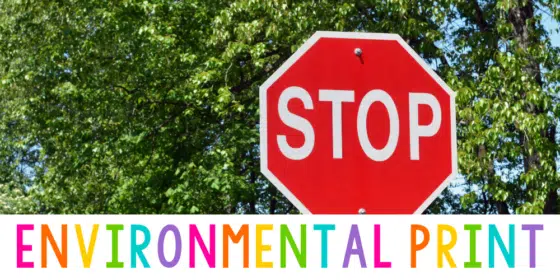
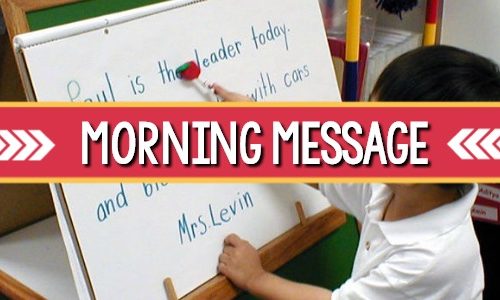

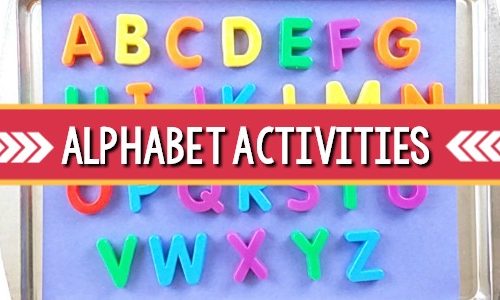
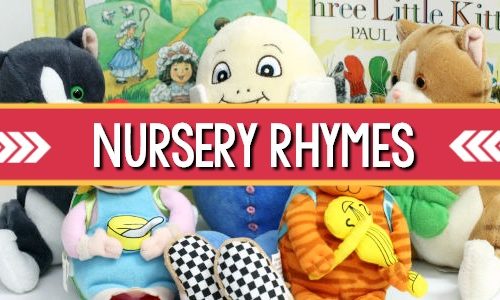
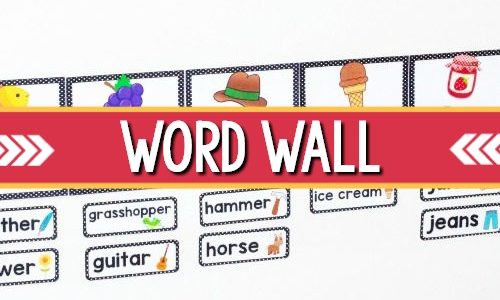
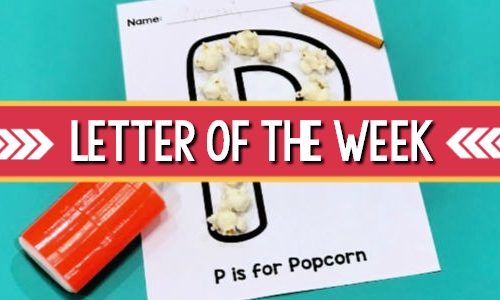
Pingback: 10 tips for circletime in the preschool classroom || Teach Preschool
Pingback: Shared and Interactive Writing: Literacy Beginnings
Pingback: 10 tips for circletime in the preschool classroom | Teach Preschool
I was reading your article about Morning Message in preK and preschool. Do you recommend doing it the same way (not pre-written and with no blanks) in kindergarten (with minor adjustments since the children are older and most likely have acquired more literacy skills)?
Yes 🙂
as the year progresses, do you add to the message or change it at all?
Yes! As the children learn and grow we change things up to meet them where they’re at.
what kind of things do you add to the message? I love writing the morning message with my kids and they love it but I’m never sure what to add to the message.
I start the year by asking one child to tell me something they “like” and then we gradually move on from there. By the end of the year the child can say anything they want, but I’m there to help scaffold and paraphrase as needed.
This post has been so helpful and I am so excited to introduce this style of Morning Message with my students!
When you say, they can share anything, are you asking them for a “Good Thing,” are you asking them a specific question, or are they sharing any random thought or idea??
Thanks Alyson! In the beginning I do ask them something specific – like favorite food etc. just to introduce the concept. But once they get the hang of it, I open it up and allow them to share anything.
Do you use lined or unlined chart paper?
Love the video! Thanks
unlined, but it can be difficult to find these days
Our school is tight on space. What do you think of using a whiteboard?
You gotta do what you gotta do! But if you have a whiteboard then it’s just as easy to slap a piece of paper up there and attach it with magnets 🙂
I really like these ideas, but curious if you would recommend using these same methods with 2.5 year olds.
No, definitely not for 2.5 year olds. Their time will be best spent focusing on pre-cursors to the morning message, such as listening to a story, singing, sharing etc.
I used this approach this morning and the kids loved it! Thanks so much!
That’s awesome, thanks for sharing!
I teach the 3s class. Would you recommend this for their age group. Also we teach upper case letter recognition but only learn lower case for their name( confusing I know). Would you suggest I write in upper and lower.
Thank you for stopping by. I do not recommend this version for 3 year olds. Their time will be best spent focusing on pre-cursors to the morning message, such as listening to a story, singing, taking turns, sharing etc.
I LOVE this idea. I use a calendar now for my 3-5’s but really only focus on counting the numbers and using it to show birthdays, special events and when it’s time to change classroom jobs.
I’m happy to pitch it in place of a morning message.
Time wise, how long should you spend on the morning message? Do you use the same skill each day or does it vary? Do you keep the message up all day and use it as a transition to teach a skill?
In the beginning of the year in PK4 it’s only a quick 2-3 minutes tops. By the end of the year it can be longer as their attention spans have increased. The things I focus on each day depend on the needs of my students and what the message says. It’s not a rigid thing that you need a script to follow or a day-by-day plan. The message remains on our chart stand in the group area all day and children like to use pointers and other tools to “read” it when they play teacher during center time. You can keep them for a week and place them on your walls for the children to read at eye level if you have the space. Some teachers also send the messages home with the student who helped compose the message.
I teach 3, 4, and 5 year o!ds. Sometimes I have a hard time thinking of ideas for morning message any greeting time. Thank you for all the exciting info.
I scrolled down for the morning message games but didn’t see them.
My apologies, I should have used the word “activities” instead of “games.” I have updated the text to reflect this change. The activities are at the very bottom of the page under the heading “Morning Message Activities”
Do you rainbow write their whole name each day or just first letter ?
I am guessing the activities you do with them each day? Is this something separate from calendar or other circle time activities?
Just the first letter. We do this daily during our large group time, but you can do it any time you prefer.
Okay! This is separate from the writing that’s done on the morning message? Sounds like you write the letter of the child’s name on large paper or on price of paper projected through Elmo and then they rainbow write? I was thinking it was the first name of their name on the message that’s written on the chart paper.
You can reach out via email here: https://www.pre-kpages.com/contact/
Would you mind adding a link for the 2 inch correction tape? I have looked at Amazon, and I can seem to find what I think you are talking about.
Thank you!!
Sure! Here you go: https://amzn.to/2XQaBRj
I was wondering what ELMO is.
It’s the brand name of a specific document projector.
Do you send the paper home with the leader every day? OR
At the beginning of the year would you do a different child each day and write all the sentences on the same page until it is all used up?
Actually, I use one paper each day. I don’t like to have more than one message on a single sheet of chart paper to eliminate any confusion for the children, especially in the beginning. You can cut chart paper in half or in sections and attach it to your easel or whiteboard. I only send them home periodically, when they start to pile up.
Do you have suggestions for how to make this work with distance learning?
You can use your phone as a document camera for virtual lessons, but their attention spans are even shorter on virtual lessons. Have you watched my Distance Learning Roadmap webinar yet? In that training you will learn the components of an effective virtual lesson for young children. The webinar is included in our Distance Learning Bundle here https://www.pre-kpages.com/products/pre-k-at-home-lesson-plan-bundle/
Is there a resource book you use for shared writing/ interactive writing ?
Literacy Beginnings by Fountas and Pinnell
Thank you for this explanation of what a morning message is appropriate for Pre-K. Before I found this, I was lost as to what to look for in regards to what we would do for our first part of the day.